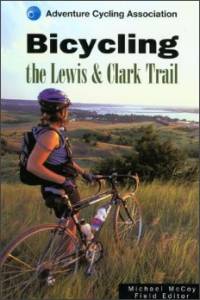Bicycling the Lewis & Clark Trail is "the cyclist's indispensable handbook to the route of the Lewis and Clark expedition. Filled with detailed maps, information on road surfaces and traffic, and a wealth of historical detail, it guides the modern adventurer through the spectacular country first recorded by Lewis and Clark."
"Retrace Meriwether Lewis and William Clark's historic expedition from the saddle of the ultimate touring machine - your bicycle. From Hartford, Illinois (outside St. Louis) to Astoria, Oregon, at the mouth of the Columbia River, the Lewis & Clark Trail passes through eleven states and winds more than 3,200 miles. As it traverses the Missouri and Columbia river basins, the trail skirts corn and wheat fields, rolls across high prairie, descends into deep gorges, and penetrates Pacific Northwest rain forest. And all along the way, there are reminders of the Corps of Discovery's epic journey."
Cycling Across North America was written by Michael McCoy of the Adventure Cycling Association, and published in 2003.
Learn more: Bicycling the Lewis & Clark Trail
Excerpt from Bicycling the Lewis & Clark Trail
The following is a short excerpt from the book, covering the brief section of the Lewis & Clark Trail through northeastern Kansas:
Soon you'll cross a narrow bridge spanning the Missouri and enter the bustling minicity of Atchison, Kansas, where just north of town the Missouri River welcomes Independence Creek to its waters. The creek was named by Lewis and Clark in honor of their camping here on July 4, 1804, the twenty-eighth birthday of the United States. If you want to look hard and long enough in Atchison, you'll find at least five good museums. One of them celebrates an American explorer who traveled by air rather than water: Aviator Amelia Earhart was born in her grandparents' house in Atchison on July 24, 1897, and grew up in the area. The Amelia Earhart Birthplace Museum (223 North Terrace Street, Atchison, KS 66002; 913-367-4217) is open year-round Monday through Saturday, 10:00 A.M. to 4:00 P.M., and Sunday, 1:00 to 4:00 P.M. To learn about the other museums in town, drop in at the visitor information center housed in the restored Santa Fe Depot (you ride right by it, so you can't miss it).
As you get back into the country, you may suddenly notice that nearly everyone driving a vehicle waves as he or she passes – Kansas has garnered a reputation among touring cyclists as the friendliest state in the country, and rightly so. North of Atchison, the route is characterized by rather steep hills holding terrace farming, big barns, small country cemeteries, and the occasional ornate but worn-down Victorian farmhouse. This northeast corner of Kansas is the state's glaciated region; it was covered by at least two of the dozen or so glaciers that advanced across much of the northern United States during the Pleistocene Epoch. A bedrock of limestones and shales is sometimes buried beneath deep deposits of glacial drift, or soils, that the glaciers left behind as they retreated.
At Troy leave the route and ride 0.5 mile to the downtown district to view the classic town square with its streets of brick surrounding the century-old, Romanesque-style Doniphan County Courthouse. On the south side of the grand brick-and-block structure awaits a special treat: Peter Wolf Toth's Tall Oak, which the artist carved in 1978 from a huge bur oak log. Toth's goal was to complete at least one monument to a Native American tribe in every state of the nation – a goal that he's reached, and then some. This was the Hungarian native's twenty-ninth in a series of more than sixty sculptures (he's done more than one in some states and has also branched out into Canada). It is unique from the others in that the feathers, neck broach, and headband represent composites of the styles worn by this region's Iowa, Kickapoo, Pottawatomie, and Sac and Fox Indians.
At Sparks (Mile 44.5) leave the route and go 2 miles west on 240th Street, then turn north onto Elgin to reach the Native American Heritage Museum (1727 Elgin Road, Highland, KS 66035; 785-442-3304). Open Wednesday through Saturday from 10:00 A.M. to 5:00 P.M. and Sunday from 1:00 to 5:00 P.M., the site is maintained by the Kansas Historical Society. Housed in the old Highland Mission, a former Sac and Fox Indian mission situated along a branch of the Oregon Trail, the museum contains a wealth of crafts, artwork, interactive exhibits, and other information on the peoples who called this region home before Lewis and Clark came through – from the Paleoindians of some 12,000 years ago to the tribes that still reside on Kansas reservations.
Continuing north from Sparks, you'll come up against high river bluffs where loess (luss) soils like those you'll be seeing off and on for the next few hundred miles are well exposed; then, before reaching White Cloud, you'll come in right beside the muddy Missouri. At the Kansas-Nebraska border, stop to read the sign interpreting the history of how and when the area was first surveyed. Above this point, a cast-iron monument was erected in 1855, establishing the baseline of the important fortieth parallel.
Learn more about the Lewis and Clark Bicycle Trail through Kansas.




